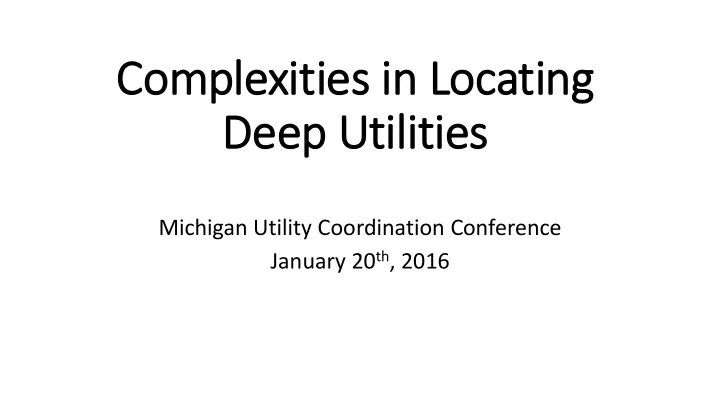

Comple lexities in in Locating Deep Util ilities Michigan Utility Coordination Conference January 20 th , 2016
Project Design Phase • Advance utility relocations • Deep utility relocations may be problematic during construction • Excavators need to expose utilities prior to excavation
MIS ISS DIG IG UNDERGROUND FACIL ILITY DAMAGE PREVENTION AND SAFETY ACT CT Act 174 of 2013 effective April 1, , 2014
Act 174 of 2013 2013 460.725 Duty of excavator to provide dig notice to notification system; contents of notice; validity of ticket; compliance with procedures and requirements; exposure of facility ; notice requirements; excavation using power equipment.
Act 174 of 2013 excerpt 460.725 Sec. 5. (5) . . . before blasting or excavating . . . an excavator shall expose all marked facilities . . . If conditions make complete exposure of the facility impractical, an excavator shall consult with the facility owner or facility operator to reach agreement on how to protect the facility . . .
Act 174 of 2013 2013 460.725 Sec. 5. (8) An excavator shall provide notification to the notification system requesting additional assistance if the location of a marked facility within the approximate location cannot be determined.
Act 174 of 2013 2013 460.723 Definitions. Sec. 3. (a) "Additional assistance" means a response by a facility owner or facility operator to a request made by an excavator during business hours, for help in locating a facility.
Act 174 of 2013 2013 460.727 Marking facility location; positive response; additional assistance of facility owner or operator upon request by excavator; damage to facility; emergency response; construction of new facility.
Act 174 of 2013 excerpt 460.725 Sec. 7. (5) . . . facility owner or facility operator shall provide additional assistance to an excavator . . .
Act 174 of 2013 2013 460.723 Definitions. Sec. 3. (a) "Additional assistance" means a response by a facility owner or facility operator to a request made by an excavator during business hours, for help in locating a facility.
Act 174 of 2013 • Act is silent on the responsibilities of an Excavator or Utility Owner if “agreement” is not reached • Could impact a Roadway Owner’s project schedule • Roadway Owner may need to provide resolution • MDOT Case Example
Jefferson Bridge over RR cut Reroute of 12 ducts, 4 Subtransmission and 2 distribution circuits due to bridge demo (4 bore shots)
DTE ”As - Built”
DTE “As - Built”
Day 1 After Being Contacted by Construction Contractor DTE markings on the wall placed previously by DTE Contractor while boring under the Railroad Bed are in Pink
Day 1 after Miss Dig “re - located” facilities Miss Dig Markings near identical to construction marks
Day 2: DTE Contractor, Miss Dig, and Construction Contractor meet to relocate DTE Contractor uses “ Sonde ” to locate all “empty” duct bundles. (Note close proximity to Casing bore) Miss Dig uses connection to our facilities for more accurate reading
Day 2 Resulting location from Contractor “ Sonde ” DTE Contractor locates all “empty ducts, marks and labels them for drawing with depths Shows approximate Width and Location of facilities Numbers correspond with Duct numbering on “As - built”
“As - Built” detail with Field Notes Drawing was provided to Contractor as reference for remaining Casings to be completed (One for East Side and one for West side of Railroad Bed) after Sonde locating
Locating Deep Utilities
Vacuum Excavation Vehicles Typical Depth under Ideal Conditions; Typical Depth under Ideal Conditions; 15’ to 20’ 10’ to 12’
Primary Geophysical Methods – Designating Equipment Pipe & Cable Locators 3M Dynatel 2250 Radiodetection 400 Multi-Frequency Multi-Frequency 5772Hz 8Khz 33KHz 133Khz 512Hz 8KHz 33Khz 65KHz Low Medium High Low Medium Metrotech 530 Metrotech 810 Single Frequency Single Frequency 332KHz 83KHz High High Subsite 950 Rycom 8876 Multi-Frequency Dual Frequency 512Hz 1Khz 8KHz 29Khz 80KHz 815Hz 82KHz Low Medium High Low High Pipehorn Metrotech 9890xt Multi-Frequency Single Frequency 480 KHz 982Hz 9.8KHz 82KHz Very High Low High
Electromagnetic Tools • VIVAX Loc-150Tx
Limitations of Pipe and Cable Locating Devices (Electromagnetic) Nonconductive Utilities: Equipment relies on the transmission of an electrical signal along a continuous conductive (metallic) conduit. Nonconductive utilities (e.g. fibers without metallic sheathing) cannot be identified with these tools. Poor Soil Conditions: Highly conductive soils (e.g. saturated clay) can render the use of lower frequencies ineffective. Conversely, extremely nonconductive soils (e.g. dry sand) can make it difficult to establish a sufficient ground connection to complete the necessary circuit. Utility Congestion: Higher frequencies are susceptible to interference via “bleed over” to adjacent metallic conductors (utilities) in areas of high utility congestion. Extremely congested areas can sometimes make utility designating very challenging. Excessive Utility Depths: All equipment has a threshold after which a signal cannot be detected. The depth of this threshold depends on soil conductivity, utility composition, transmitter power output, and the specific design of the piece of equipment.
Non-Tonable Utilities Sewer Lines Empty Conduits Detectable fiberglass duct rodders (multi-duct and sub-duct systems) Beacons \ Sondes and Camera systems (non-tonables)
Gyroscopic Utility Mapping 10-11 JAN 2012
Recommend
More recommend